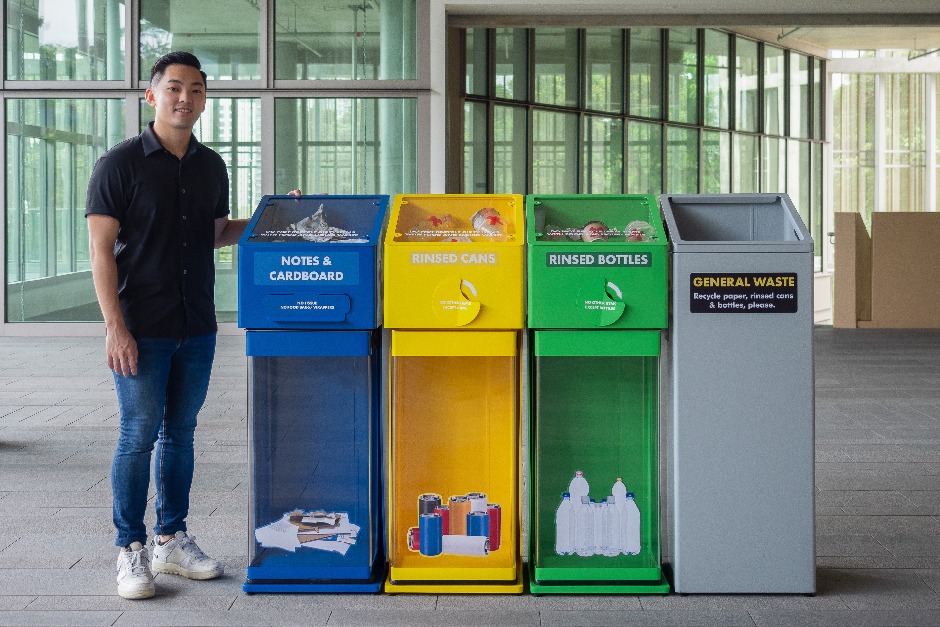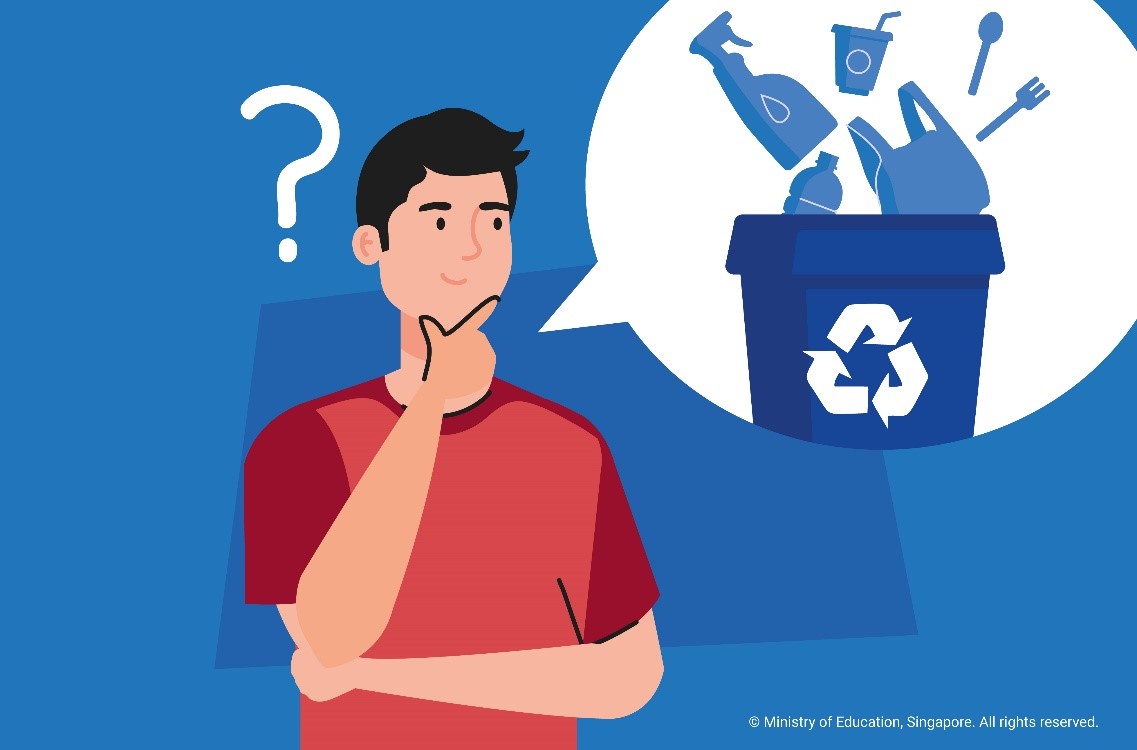Like many other undergraduates, Tommy Cheong’s last semester at the National University of Singapore (NUS) was primarily taken up by his Final Year Project (FYP). However, unlike many of them, much of his time was spent neither in the lab nor the library, nor behind a computer.
His research site was the campus canteen. His tools? A pair of tongs, a mask and a pair of sturdy rubber gloves.
Twice a week for 3 months, Tommy spent his afternoons “dumpster diving”. His mission: to find out what people are throwing into the recycling bins, and find ways to ensure their efforts do not go to waste.
What does this mean? Plastic bottles and cans should ideally be rinsed, or at least emptied, before they go into the recycling bins. Yet, most of the items that people toss into the bins contain residual food and liquid waste – these end up in the landfill because they can’t be recycled.
So, if you have ever thrown a bubble tea cup with leftover pearls and ice (plastic cup, right?) into the plastic recycling bin, you have probably contributed to the contamination problem. It’s not just you; many people are unaware of this issue.
With the help of the cleaners, Tommy would wheel the recycling bins behind the canteen, pour out the contents and sort them into two piles – that which was acceptable, e.g. clean plastic bottles and drink cans, and that which was not, e.g. food containers, styrofoam cups and tissues.
By bagging and weighing the two, Tommy would get a measure of how contaminated the bins were.
“My course mates would sometimes find me behind the canteen crouched over a heap of trash,” Tommy laughed. “I told them this was part of my FYP, and some of them would look kind of sceptical. But it’s ok, this is something I chose!”
Tackling real problems outside the classroom
Tommy’s interest in sustainability grew during his time as an Industrial Design student in polytechnic.
“I learned that in making any kind of product, there is inevitably some kind of waste. That’s when I became more eco-conscious and resolved to design things that are both purposeful and sustainable.”
It was in NUS that Tommy learnt about the issue of contamination in recycling. While helping his senior in a project in 2018, he found out that almost all the plastic recyclables collected in Singapore are rejected by recycling companies.
This issue stuck with him, so when it was his turn to embark on his FYP, Tommy decided to build on his seniors’ project. He reached out to the NUS administration and offered to work on a bin design to tackle this problem. Happily, they were keen to collaborate.
“I think student projects tend to be short-lived,” Tommy reflected. “By working with the NUS administration, I hoped to test my ideas on the ground, and make a real impact beyond my FYP.”
To understand how people deal with their trash, Tommy carried out surveys and observation studies at the recycling points. He also conducted user testing sessions to get feedback on different bin designs. For example, through a card sorting exercise, he found that images of the actual items on bins were more effective than generic icons in getting people to recycle correctly.
.jpg)
In the card sorting exercise, participants reacted to different images (real vs icons) and explained what they thought were recyclable and non-recyclable.
“What we found is that most people want to recycle,” Tommy explained. “However, they are not aware that items containing food waste can’t be recycled. No one contaminates the bins on purpose!”
“There is never a final final design”
With the insights derived from the surveys and user testing sessions, Tommy set out to redesign the bins with an unusual goal – to make it less convenient for users to dispose of their recyclables.
This sounds counter-intuitive, but Tommy realised that throwing trash into the nearest receptacle is an action people do mindlessly. He wanted to introduce an obstacle to disrupt this “auto-pilot” behaviour and make people pay attention to what they are actually putting into the bins. At the same time, this obstacle should not deter people from wanting to recycle.
His solution? A smaller, slidable opening that will allow only the right items e.g. plastic bottles and cans to be slotted into the bins.
.jpg)
Other notable features on Tommy’s “Recycle Right” bins include a 3D display of actual unacceptable items to remind people on what they should avoid putting into the bins, as well as a transparent bin body to show people how others are recycling right.
The proposed bin designs were submitted for Tommy’s FYP in May last year. But he was not satisfied to let the designs remain only as conceptual drawings on paper.
With the help of a staff mentor from the NUS Waste Minimisation and Recycling Task Force, Tommy managed to secure funding from South West Community Development Council (CDC) and manufactured two sets of the bins. These trialled for 3 months in NUS’ University Town.
.jpg)
The Recycle Right bins – from prototype to reality
Two other students joined Tommy in “dumpster diving” from October to January to gather data on the effectiveness of the new bins in reducing contamination.
They found that the new bin design reduced the contamination rate of the plastic bottle recycling bins from 60% to 27%. Another unexpected benefit was that cleaners only needed to clear the bins twice a week, compared to once daily in the past. This was because there was less trash, and the transparent bins made it easier for them to know when the bins needed clearing.
.jpg)
As part of the project, Tommy and NUS staff engaged the cleaners to get their feedback on the new bins
For Tommy, this was an encouraging result for a pilot. He also explained his motivation to continue with the project even after graduation.
“Seeing my design develop from an idea to an actual object on campus means a lot to me. It’s exciting to see people actually use my product, and have it help the environment.”
In fact, Tommy is already working on a new iteration of the design. After consulting the cleaning staff on campus, he hopes to re-design the lid of the bins such that it would be easier for the cleaners to extract the contents.
“A designer’s work is never finished,” he laughed. “There’s always something we can improve on.”
The beauty of collaboration
Looking back on his “Recycle Right” journey, Tommy felt that his main takeaway was the importance of collaboration when it comes to sustainability.
“Recycling is a very complex issue, and I’m thankful that the NUS staff was willing to share their expertise when it comes to recycling operations and work with me through this whole process. They also linked me up with other partners so I could really test out my solution.”
He also appreciated the help of the two other students who joined him for the “dumpster diving” sessions and bin study.
As an economics student, Thiti Thitipankul saw the trial as an excellent opportunity to apply the statistical models and analysis skills he is learning in his course to measure the effectiveness of the new bins. The other student who helped in the data collection, Alan Matthew Anggara, majors in Mathematics. Both students got to know of the project from the NUS Waste Minimisation and Recycling Task Force.
“From Thiti and Alan, I picked up some knowledge of statistics and data analysis during the bin study. I didn’t really have experience in these areas, so it was almost like a crash course for me.”
The NUS Waste Minimisation and Recycling Task Force will be progressively rolling out Tommy’s new bins across campus starting April/May 2021. They are also working with stakeholders, such as the National Environment Agency (NEA) to test out the bins in other locations, including a primary school and shopping malls.
Tommy continues to be involved in the process on a voluntary basis, even as he starts his work in a design consultancy this year.
After all, sustainability is a mission that goes beyond one’s FYP.






